Table of Contents
Free to Be Me
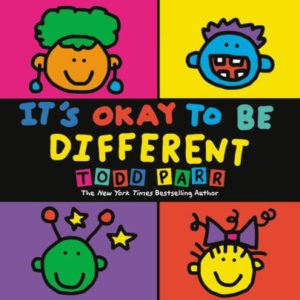 |
Todd Parr’s charmingly illustrated It’s OK to Be Different (Little, Brown, 2009) assures kids that it’s okay – to need help, to be a different color, to talk about your feelings, to have big ears. A good beginning for ages 3-6. |
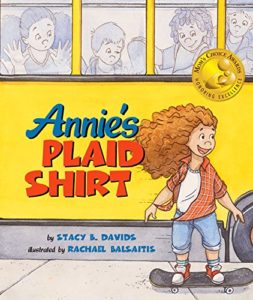 |
In Stacy B. Davids’s Annie’s Plaid Shirt (Upswing Press, 2015), Annie insists on wearing her plaid shirt everywhere. Then they’re invited to Uncle Benny’s wedding – and Annie’s mother wants her to wear a dress. But dresses simply aren’t right for Annie. For ages 3-7. |
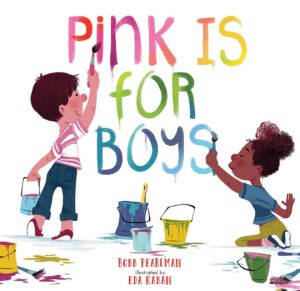 |
Robb Pearlman’s color-themed Pink Is for Boys (Running Press Kids, 2018) emphasizes that it’s all about what you love: pink is for boys (and girls); so are unicorns, racing cars, and baseball. For ages 4-7. |
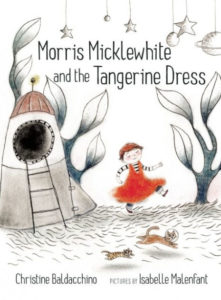 |
In Christine Baldacchino’s Morris Micklewhite and the Tangerine Dress (Groundwood Books, 2014), Morris loves wearing the tangerine dress in the class dress-up box – but he’s teased and banned from the spaceship that some of the other kids are buildingm because astronauts don’t wear dresses. Morris, however, triumphs, inventing a marvelous space adventure of his own and taking two friends along. For ages 4-7. |
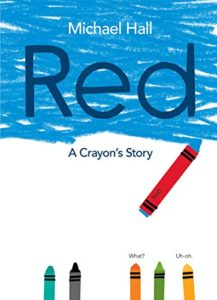 |
In Michael Hall’s Red: A Crayon’s Story (Greenwillow, 2016), a blue crayon – mistakenly labeled as red – has nothing but trouble. His teacher, mother, and friends all try to help – but nothing works until he finally discovers that he’s actually blue. A charming way to introduce gender issues for ages 4-8. See this lesson plan to accompany the book. |
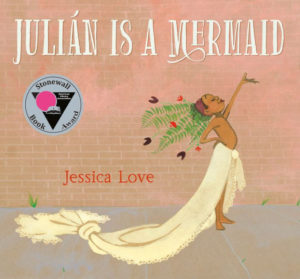 |
Jessica Love’s Julian is a Mermaid (Candlewick, 2018) is the story of Julian who – having seen people gorgeously costumed as mermaids on a train – Invents a spectacular costume of his own. For ages 4-8. |
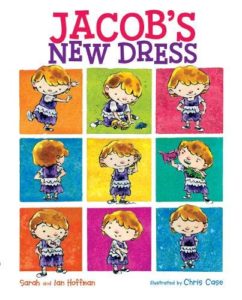 |
Sarah Hoffman’s Jacob’s New Dress (Albert Whitman & Company, 2020) begins “There are lots of different ways to be a boy.” Gender-nonconforming Jacob wants to wear a dress to school. “Well, it’s not what I would wear,” his dad says, “but you look great.” For ages 4-8. |
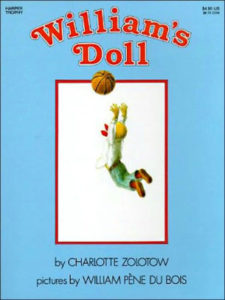 |
In Charlotte Zolotow’s delightful William’s Doll (Harper & Row, 1972), William wants a doll – despite all around him, who feel he’d be much better off with a basketball. His wise grandmother explains that William’s doll will help him learn to be a loving father. One of the first books to deal with gender stereotypes in toys. For ages 4-8. |
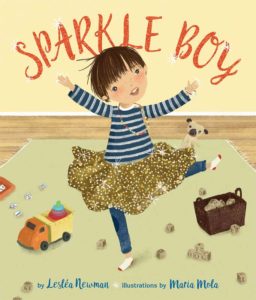 |
In Leslea Newman’s Sparkle Boy (Lee & Low, 2017), Casey loves his sister Jessie’s shimmery skirts, glittery bracelets, and nail polish. Jessie protests that boys can’t have such things – though her parents and grandmother explain that Casey can wear whatever he wants. When kids at the library tease Casey about his love of “girl” things, Jessie defends Casey’s right to be himself. A lovely story for ages 5-8. |
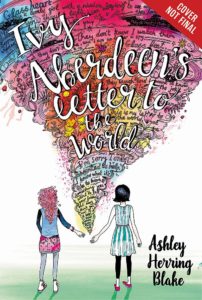 |
Those of us who grew up with Harriet the Spy know that it’s bad news to lose a diary. In Ashley Herring Blake’s Ivy Aberdeen’s Letter to the World (Little, Brown, 2019), Ivy does just that in the wake of a tornado – and then her secret pictures of girls holding hands begin to reappear, with notes urging her to reveal her true identity. For ages 8-12. |
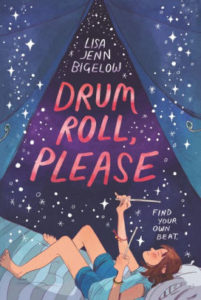 |
In Lisa Jenn Bigelow’s Drum Roll, Please (HarperCollins, 2019), Melly and her best friend Olivia spend the summer at rock-and-roll Camp Rockaway, where Melly has to deal with her parents’ divorce, the loss of her best friend, and her new feelings for another girl. For ages 8-12. |
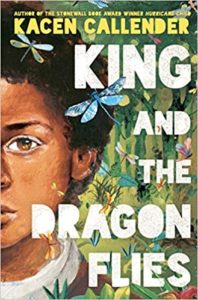 |
In Kacen Callender’s King and the Dragonflies (Scholastic, 2020), 12-year-old King is dealing both with the death of his older brother, his father’s definition of what it takes to be a man, and his feelings for his (male) friend Sandy. A haunting and wonderful story for ages 9-12. |
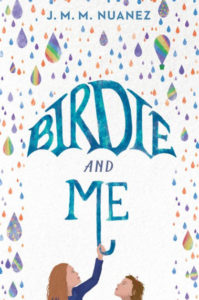 |
In J.M.M. Nuanez’s Birdie and Me (Puffin, 2021), 12-year-old Jack (short for Jacqueline) and her little brother, Birdie, after their mother’s death, have been sent first to live with sweet, but irresponsible Uncle Carl, then with gruff and conventional Uncle Patrick. There Birdie, who favors pink leggings and nail polish and maintains a “Book of Fabulous,” runs into trouble: Uncle Patrick, worried that Birdie will be prey to bullies, tries to force him to conform to gender norms. It’s a story of adults and children learning to understand each other as they gradually form a new and larger family. For ages 10-12. |
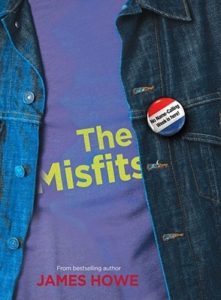 |
In James Howe’s The Misfits (Atheneum, 2003), the four misfits – Bobby, an overweight 12-year-old tie salesman, rabble-rousing Addie, Skeezie, dubbed a hooligan, and Joe, who is gay – are all victims of name-calling in middle school. So they decide to do something about it. An upbeat story about the damaging effects of stereotyping and labels. For ages 10-14. |
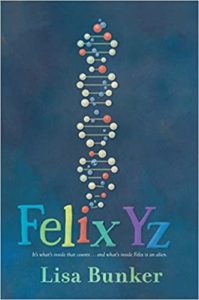 |
In Lisa Bunker’s Felix Yz (Puffin, 2018), 13-year-old Felix’s brain is fused with that of a Zyx, a hyperintelligent fourth-dimensional being, after a science experiment went dreadfully wrong. Now the two must be separated by the Procedure, which may kill them both. The book is written in the form of Felix’s secret blog as he counts down the days until the Procedure – complicated by Felix’s problems in middle school, which include a crush on classmate Hector, and the dynamics of family life, which include a very cool gender-unusual grandparent who divides the week between male and female personas. For ages 10-14. |
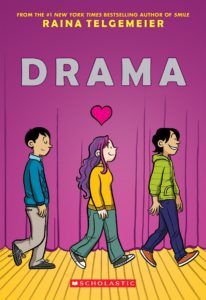 |
Raina Telgemeier’s Drama (Graphix, 2012) is a graphic novel about a middle-school drama production – set against a background of burgeoning middle-school social relationships. Praised for its positive depiction and normalization of LGBTQ characters through Jesse and Justin, a pair of talented gay twins. For ages 10-14. |
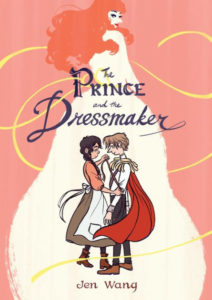 |
In Jen Wang’s The Prince and the Dressmaker (First Second, 2018), Prince Sebastian is supposed to be looking for a bride – but actually is spending his time donning gorgeous dresses and wowing Paris society in the guise of the Lady Crystallia. Only Frances, the talented little dressmaker, knows his secret. A very different Cinderella story for ages 12 and up. |
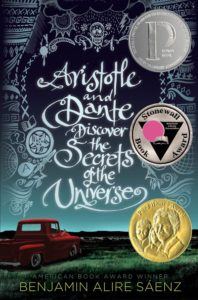 |
Benjamin Alire Saenz’s Aristotle and Dante Discover the Secrets of the Universe (Simon and Schuster, 2014) is a thoughtful and complex coming-of-age story about two boys falling in love: 15-year-old Aristotle (Ari), coping with a brother in prison and a father suffering from PTSD, and Dante, passionate about art and books. For ages 13 and up. |
